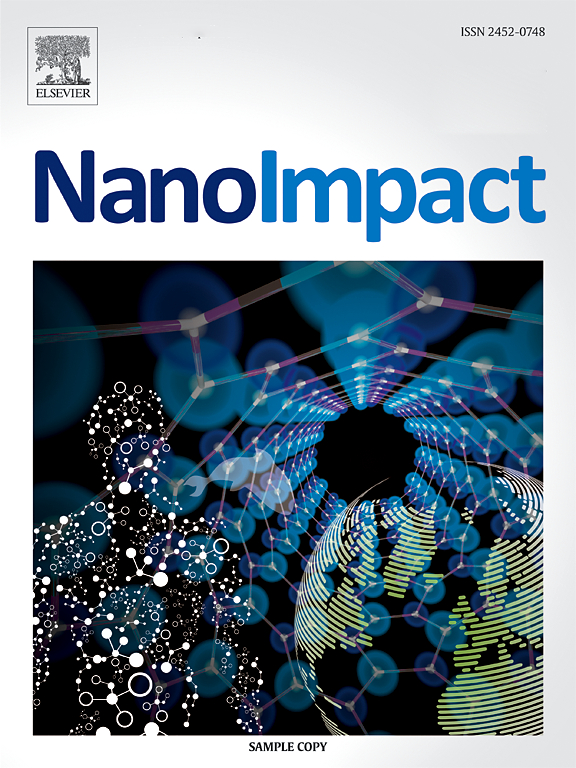在细胞培养实验中,分散方案对先进纳米材料的生物分子电晕影响最小
IF 5.5
3区 环境科学与生态学
Q2 ENVIRONMENTAL SCIENCES
引用次数: 0
摘要
工业部门已经大量投资于先进纳米材料(NMs)的使用,目前正在广泛应用中实施。然而,对生物和环境的潜在暴露仍然是一个问题。虽然其中一些材料的设计不适合在水介质中分散,但开发分散方案以确保与体外和体内试验的兼容性对于正确评估研究至关重要。生物介质表面形成的生物分子电晕会显著影响纳米粒子在生物介质中的身份。然而,这种电晕可能受到分散方法的影响,改变了它们的物理化学特性,并使对它们与生物系统相互作用的理解复杂化。因此,了解分散方案的效率及其对NMs生物特性的影响是至关重要的。然而,关于分散协议影响的系统研究仍然缺乏,使这成为该领域一个至关重要但被忽视的方面。本研究旨在比较两种标准分散方案(通常称为Harvard和Nanogenotox),并评估它们对先进工业NMs中生物分子电晕形成的影响。为此,研究人员使用了不同的技术来评估日冕中的颗粒大小、胶体稳定性和离子释放,以及蛋白质和唾液酸的含量和丰度。结果表明,分散方案适度地改变了纳米颗粒的大小和团聚状态,蛋白质组学分析表明,每种纳米颗粒类型形成不同的电晕,受到不同表面修饰的影响。纳米基因毒素方案中牛血清白蛋白(BSA)的存在对两种方案之间蛋白质组成的总体趋势影响最小。这些发现强调了分散方案在纳米毒理学分析中的重要性,并表明这些方法之间的差异在形成先进和多组分纳米颗粒的生物特性和潜在生物效应方面并不起决定性作用。本文章由计算机程序翻译,如有差异,请以英文原文为准。

Dispersion protocols have minimal impact on the biomolecular corona of advanced nanomaterials in cell culture assays
Industrial sectors have largely invested in the use of advanced nanomaterials (NMs), which are currently being implemented in a wide range of applications. However, the potential exposure to living beings and the environment still remains a concern. While some of these materials were not designed to be dispersible in aqueous media, the development of dispersion protocols to ensure compatibility with the in vitro and in vivo assays has become crucial for the correct assessment of the studies. NMs' identity in biological media is significantly influenced by the formation of a biomolecular corona on its surface. However, this corona might be affected by the dispersion method, altering their physicochemical characteristics and complicating the understanding of their interactions with biological systems. Therefore, understanding the efficiency of dispersion protocols and their influence on the biological identity of NMs is fundamental. However, systematic studies on the effects of dispersion protocols are still lacking, making this a crucial yet overlooked aspect in the field. This study aims to compare two standard dispersion protocols, commonly known as Harvard and Nanogenotox, and evaluate their impact on the biomolecular corona formation across a selection of advanced industrial NMs. To this aim, different techniques were used to assess particle size, colloidal stability and ion release, as well as protein and sialic acid content and abundance in the corona. Results show that the dispersion protocol modestly alters nanoparticle size and agglomeration state, and proteomics analysis revealed that each nanoparticle type forms a distinct corona, influenced by the distinct surface modifications. The presence of bovine serum albumin (BSA) in the Nanogenotox protocol minimally affected the overall trends in protein composition between the two protocols. These findings emphasize the significance of the dispersion protocol in nanotoxicology assays and demonstrate that variations between these methods do not play a decisive role in shaping the bio-identity and potential biological effects of advanced and multicomponent NMs.
求助全文
通过发布文献求助,成功后即可免费获取论文全文。
去求助
来源期刊

NanoImpact
Social Sciences-Safety Research
CiteScore
11.00
自引率
6.10%
发文量
69
审稿时长
23 days
期刊介绍:
NanoImpact is a multidisciplinary journal that focuses on nanosafety research and areas related to the impacts of manufactured nanomaterials on human and environmental systems and the behavior of nanomaterials in these systems.
 求助内容:
求助内容: 应助结果提醒方式:
应助结果提醒方式:


